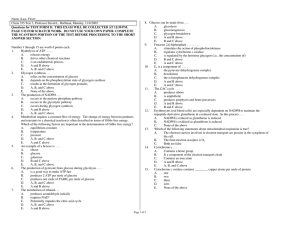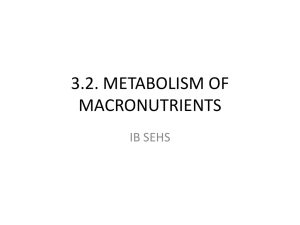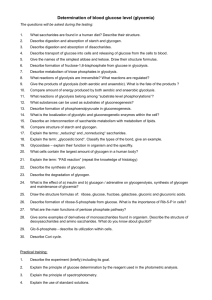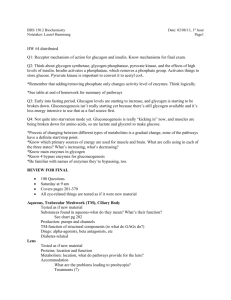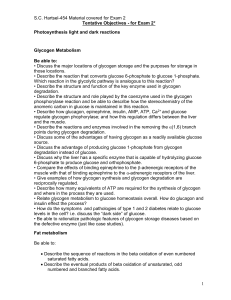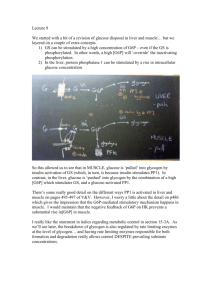Test3 Fall 02
advertisement
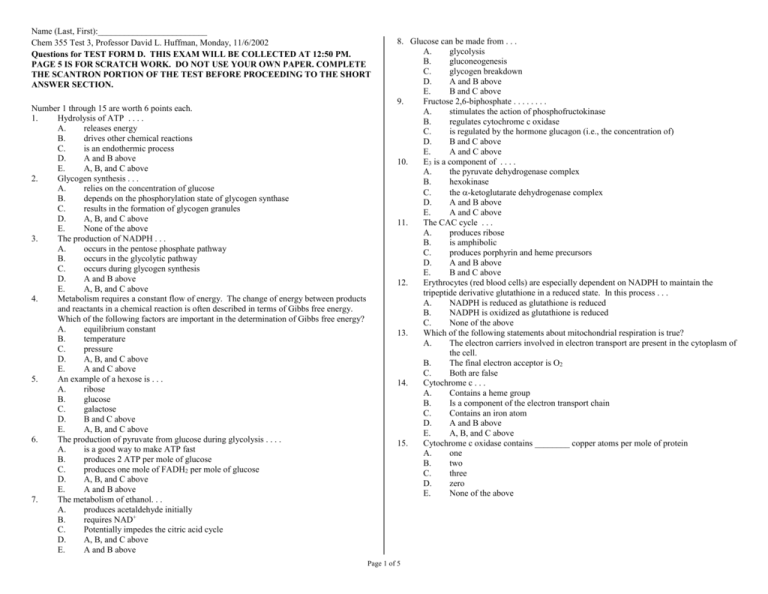
Name (Last, First):_________________________ Chem 355 Test 3, Professor David L. Huffman, Monday, 11/6/2002 Questions for TEST FORM D. THIS EXAM WILL BE COLLECTED AT 12:50 PM. PAGE 5 IS FOR SCRATCH WORK. DO NOT USE YOUR OWN PAPER. COMPLETE THE SCANTRON PORTION OF THE TEST BEFORE PROCEEDING TO THE SHORT ANSWER SECTION. Number 1 through 15 are worth 6 points each. 1. Hydrolysis of ATP . . . . A. releases energy B. drives other chemical reactions C. is an endothermic process D. A and B above E. A, B, and C above 2. Glycogen synthesis . . . A. relies on the concentration of glucose B. depends on the phosphorylation state of glycogen synthase C. results in the formation of glycogen granules D. A, B, and C above E. None of the above 3. The production of NADPH . . . A. occurs in the pentose phosphate pathway B. occurs in the glycolytic pathway C. occurs during glycogen synthesis D. A and B above E. A, B, and C above 4. Metabolism requires a constant flow of energy. The change of energy between products and reactants in a chemical reaction is often described in terms of Gibbs free energy. Which of the following factors are important in the determination of Gibbs free energy? A. equilibrium constant B. temperature C. pressure D. A, B, and C above E. A and C above 5. An example of a hexose is . . . A. ribose B. glucose C. galactose D. B and C above E. A, B, and C above 6. The production of pyruvate from glucose during glycolysis . . . . A. is a good way to make ATP fast B. produces 2 ATP per mole of glucose C. produces one mole of FADH2 per mole of glucose D. A, B, and C above E. A and B above 7. The metabolism of ethanol. . . A. produces acetaldehyde initially B. requires NAD+ C. Potentially impedes the citric acid cycle D. A, B, and C above E. A and B above 8. Glucose can be made from . . . A. glycolysis B. gluconeogenesis C. glycogen breakdown D. A and B above E. B and C above 9. Fructose 2,6-biphosphate . . . . . . . . A. stimulates the action of phosphofructokinase B. regulates cytochrome c oxidase C. is regulated by the hormone glucagon (i.e., the concentration of) D. B and C above E. A and C above 10. E3 is a component of . . . . A. the pyruvate dehydrogenase complex B. hexokinase C. the -ketoglutarate dehydrogenase complex D. A and B above E. A and C above 11. The CAC cycle . . . A. produces ribose B. is amphibolic C. produces porphyrin and heme precursors D. A and B above E. B and C above 12. Erythrocytes (red blood cells) are especially dependent on NADPH to maintain the tripeptide derivative glutathione in a reduced state. In this process . . . A. NADPH is reduced as glutathione is reduced B. NADPH is oxidized as glutathione is reduced C. None of the above 13. Which of the following statements about mitochondrial respiration is true? A. The electron carriers involved in electron transport are present in the cytoplasm of the cell. B. The final electron acceptor is O2 C. Both are false 14. Cytochrome c . . . A. Contains a heme group B. Is a component of the electron transport chain C. Contains an iron atom D. A and B above E. A, B, and C above 15. Cytochrome c oxidase contains ________ copper atoms per mole of protein A. one B. two C. three D. zero E. None of the above Page 1 of 5 Name (Last, First):_________________________Chem 355, Professor David L. Huffman, Test 3, FORM D SHORT ANSWER PORTION OF TEST. VARIABLE NUMBER OF POINTS. TELL ME WHAT YOU KNOW. DO NOT LEAVE ANSWERS BLANK. PLACE YOUR ANSWER WITHIN THE BOX TO RECEIVE CREDIT 16. 17. Discuss the effect of phosphorylation on glycogen metabolism and glycolysis. Mention at least one hormone. (15 points) 16. Page 2 of 5 Discuss at least three ways in which the citric acid cycle can be regulated (15 points) 17. Name (Last, First):_________________________Chem 355, Professor David L. Huffman, Test 3, FORM D 19. 18. Describe how electrons flow in the electron transport chain. Mention the sources of reducing equivalents. (15 points) What is lactose intolerance? (10 points) 19. 18. 20. Draw the structure of heme or glucose or fructose or ribose or galactose (5 points). 20. Page 3 of 5 Name (Last, First):_________________________Chem 355, Professor David L. Huffman, Test 3, FORM D 21. Discuss a topic of your choice from metabolism that is unrelated to your previous answers. Give at least three main points (15 points) 22. 21. 22. Page 4 of 5 Discuss a transport (shuttle) mechanism and how it impacts metabolism. (15 points) Name (Last, First):_________________________Chem 355, Professor David L. Huffman, Test 3, FORM D SCRATCH PAPER. THIS IS NOT A PAGE TO PLACE ANY ANSWERS. THIS FORM MUST BE RETURNED WITH YOUR EXAM. DO NOT DETACH. Page 5 of 5
